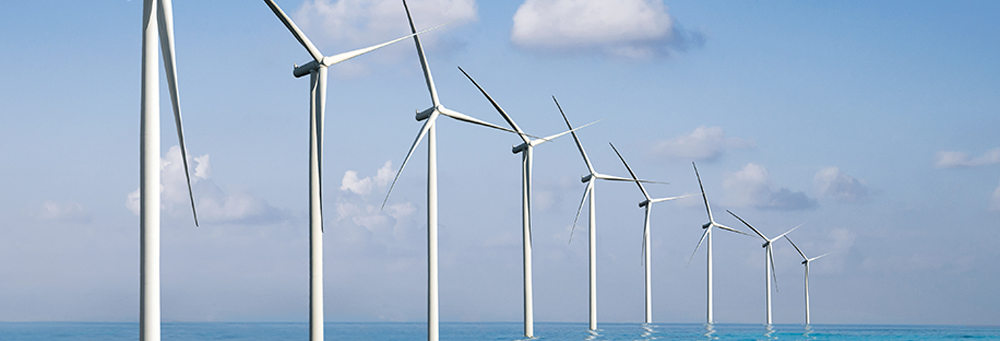HARNESSING WIND, SUN AND TECHNOLOGY
North Carolina, an established leader in renewable batteries, solar power and offshore wind energy, continues to create
new energy resources and thousands of new jobs.
—By Lawrence Bivins
Diversification has long been a hallmark of North Carolina’s economic development strategy. Emerging industries such as life sciences, data analytics and composite-based aerospace manufacturing grow alongside 21st century incarnations of the more traditional business sectors such as banking, agribusiness and distribution. Quietly taking a position next to all of them is one industry that has local and state leaders especially excited: alternative energy.
Lacking oil or gas under its soils, North Carolina has never been a player in the fossil fuel economy. But as global climate change and the need for greater energy resiliency take center stage, the state has a credible shot at being in the realm of clean energy and what Texas is to carbon-based fuels. With leadership in solar power, offshore wind and battery storage, the state stands to draw its share of energy-related businesses while sharpening the efficiency of its $731 billion economy.
“We have the assets and the ability to do this, and I’m really optimistic,” says Jennifer Mundt, assistant secretary for clean energy economic development at the N.C. Department of Commerce. She envisions opportunity for each of the state’s 100 counties to participate, and benefit from the move to cleaner energies.
“With that comes great jobs that can provide amazing opportunities for people across our state with all levels of education,” says Mundt, who served as a policy adviser at the state’s Department of Environmental Quality prior to joining Commerce in 2022.
Policy action by state leaders in 2007 set the stage for clean
energy competitiveness. That year, legislators passed the Renewable Energy and Energy Efficiency Portfolio Standard, which nudged North Carolina’s investor-owned utilities to deploy renewable energy sources for 12.5% of their retail electricity sales by 2021.
The move, which included metering arrangements giving credits to customers who produced their own renewable power, was the first of its kind for any Southeastern state. It quickly drew numerous solar energy companies, and the Tar Heel State soon ranked second in the nation in installed solar capacity behind only California.
 WHERE THE SUN SHINES
WHERE THE SUN SHINES
Though Texas and Florida have caught up, North Carolina still enjoys the fourth position nationwide in solar capacity. Its strong focus on solar gives new meaning to the line in the state’s toast: “The summer land where the sun doth shine.”
Duke Energy Progress, a unit of Charlotte-based Duke Energy that serves customers in North Carolina and South Carolina, leads Southeastern utilities for both current and anticipated deployment of renewables, according to the Southern Alliance for Clean Energy’s most recent Solar Southeast Report. Duke has retired most of its coal-burning generation stations in North Carolina, and the utility has made a commitment to cut the carbon dioxide emissions from its electrical generation in half by 2030. It is aiming for net-zero CO2 emissions by 2050.
“We had the right policy framework in place at a time when the market economics made [solar]technology more affordable,” explains Steve Kalland, executive director of the North Carolina Clean Energy Technology Center at N.C. State University. “Since 2008, we’ve seen massive growth in solar. While that growth has slowed somewhat, we remain in the nation’s top five.”
Deployment has reached into the state’s agribusiness industry, with photovoltaic panels now being installed on poultry houses in rural communities. Photovoltaic panels convert thermal energy into electricity, while solar panels convert solar radiation into heat.
Some 200 solar installment companies now operate in the state, while national companies are based here. Pine Gate Renewables’ headquarters is in Asheville, and Strata Clean Energy is based in Durham.
Federal subsidies available under the 2022 “CHIPS and Science Act” are leading key industries back to the U.S., including solar equipment manufacturers.
Some of those opportunities will find their way to North Carolina, says Kalland, whose 36-year-old organization is funded by the N.C. General Assembly, the N.C. State Engineering Foundation, and proceeds from research grants and program fees.
OFFSHORE WIND ALONG THE CAROLINA COAST
Ambitious plans for offshore wind power complement the state’s leadership in solar power. Mundt says North Carolina has a long list of advantages for wind-based energy operations and the supply-chain opportunities that come with them.
“North Carolina really rises above other states,” she says. Ample coastline with relatively shallow ocean depths boosts the state’s appeal as a backdrop for offshore wind turbines.
High-level leadership is also making an impact. A 2021 executive order by Gov. Roy Cooper commits North Carolina to producing 2.8 gigawatts of wind energy by 2030 and 8 gigawatts of offshore wind power by 2040. Executive Order 218 also established the North Carolina Task Force on Offshore Wind Economic Resource Strategies, known as “NC TOWERS.” Mundt’s team at Commerce provides staffing support for the 30-member task force, whose central objective is identifying a path forward for wind energy that harnesses the state’s myriad economic resources and transportation assets.
Offshore wind has multi-state significance for North Carolina and its neighbors. In 2017, Oregon-based Avangrid Renewables leased from the U.S. Bureau of Ocean Energy Management some 122,405 acres of water 27 miles off North Carolina’s Outer Banks for its “Kitty Hawk” wind energy project. The project aims to build 190 turbines, which would provide up to 3,500 megawatts – enough to serve electricity to 1 million homes. “The northern tranche of the project, about 40% of the total leased area, is the furthest along,” Mundt says. Its power will connect to Dominion Energy’s service network at the coastal community of Sandbridge, Virginia.
“Avangrid is evaluating landing locations for the second tranche,” Mundt says, noting it will connect to Duke Energy’s grid.
While a follow-on proposal for additional wind generation off the Outer Banks was recently nixed by the U.S. Defense Department over concerns that more turbines would complicate military flight paths, there are plans for an inland wind farm elsewhere in northeastern North Carolina. Apex Clean Energy is working with Google Sustainability, a division of the tech giant, to purchase the entire capacity of Timbermill Wind, a 45-turbine project expected to operate in Chowan County
by late 2024.
Moreover, initial data collection is underway for two offshore wind projects 22 miles south of Bald Head Island in southeastern North Carolina. Cinergy, a subsidiary of Duke Energy, is collaborating with TotalEnergies Renewables USA, the Houston-based U.S. unit of the French energy giant Total Energies. The two entities are working together to create a pair of massive wind farms that would encompass 110,000 acres of water and produce enough electricity for 750,000 homes. The project could be complete by the early 2030s.
Offshore wind alone will spark a $140 billion supply chain opportunity for the U.S. by 2035, according to a 2021 study by BVG Associates, a British consulting firm specializing in alternative energy. It would mean “tens of thousands of new jobs” in the U.S. by 2035, according to BVG, which was engaged by N.C. Commerce to help inform an economic development strategy based on offshore wind. BVG Associates’ nine-month study found that North Carolina stands to attract $100 billion in offshore wind-related investment and as many as 10,000 related jobs.
The supply chain dimension is especially attractive for North Carolina, which ranks fifth in the nation for manufacturing gross domestic product and first among East Coast states. “There are about 8,000 parts that have to be manufactured (for offshore wind) and the majority of those are smaller and do not need to be built at the coast,” Mundt says. North Carolina communities as far west as Murphy could participate in supply chain opportunities, she says.
Still, the largest beneficiaries of North Carolina’s offshore wind economy appear to be its central coastal communities. A 200-acre patch of available land adjacent the deepwater port at Morehead City known as Radio Island is the subject of planning for a possible industrial site that would support the offshore wind supply chain. The North Carolina Ports Authority, which owns the one-time site of military communications gear, is exploring upgrades to infrastructure and facilities to make Radio Island a multi-use asset for companies engaged in offshore wind and automotive production, another budding state industry.
Working with Gov. Cooper, legislators have allocated $20 million to ready the property.
While discussions are in the early stages, environmental impact modeling includes scenarios for manufacturing, warehousing, new rail spurs and additional berthing space large enough to accommodate the staging of huge turbine blades. Sketches also include capacity for roll-on/roll- off, or “RORO,” piers typically used to facilitate the intermodal movement of motor vehicles. ■


